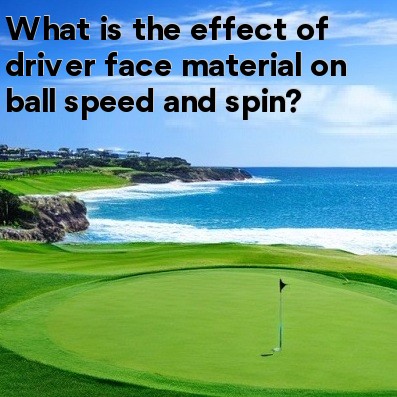
The Effect of Driver Face Material on Ball Speed and Spin
When it comes to golf, technology has played a significant role in improving various aspects of the game. One area where advancements have been made is in driver face materials. The material used in the construction of the driver face can have a notable impact on ball speed and spin. Let's explore the effects of different driver face materials.
1. Titanium
Titanium has been the preferred choice for driver face materials for many years. It is known for its high strength-to-weight ratio, which allows for larger and thinner faces. A larger face means a larger sweet spot, increasing forgiveness on off-center hits. Additionally, the thinness of the face allows for better energy transfer, resulting in higher ball speeds.
However, titanium face drivers tend to produce lower spin rates. This can be beneficial for golfers with high swing speeds as it promotes a more penetrating ball flight and increased roll on the fairway. Conversely, golfers with slower swing speeds may struggle to generate enough backspin to keep the ball airborne and may experience a lack of control off the tee.
2. Stainless Steel
Stainless steel is a more common material used in mid-range or budget-friendly drivers. While it may not offer the same performance capabilities as titanium, stainless steel still provides decent ball speed and forgiveness.
Compared to titanium, stainless steel has a slightly higher spin rate. This can help golfers with slower swing speeds generate more lift and keep the ball in the air longer. Higher spin rates also provide additional stopping power on the greens, allowing golfers to control their approach shots better.
3. Composite
Composite materials, such as carbon fiber, have gained popularity in recent years due to their unique properties. These materials are lighter than titanium and steel, allowing manufacturers to redistribute weight to other areas of the clubhead for better forgiveness.
Composite face drivers have the advantage of being able to fine-tune ball flight characteristics. Manufacturers can manipulate the thickness and composition of the materials to adjust ball speed, spin, and launch angle. This makes composite face drivers highly customizable for individual golfers and their specific swing characteristics.
4. Face Inserts
Another approach to enhancing driver performance is the use of face inserts. These inserts are typically made of different materials, such as rubber or polymer, to optimize ball speed and spin.
Face inserts can help minimize the energy loss on off-center hits, leading to increased ball speed. Some inserts are designed to promote higher spin rates, while others aim for lower spin for those seeking more distance and roll.
Conclusion
The choice of driver face material can significantly impact ball speed and spin in golf. Titanium provides high ball speeds and lower spin rates, while stainless steel offers more forgiveness and slightly higher spin. Composite materials allow manufacturers to fine-tune performance characteristics, making them highly customizable. Face inserts also play a role in optimizing ball speed and spin. Ultimately, golfers should consider their swing characteristics and personal preferences when selecting a driver with the ideal face material for their game.





